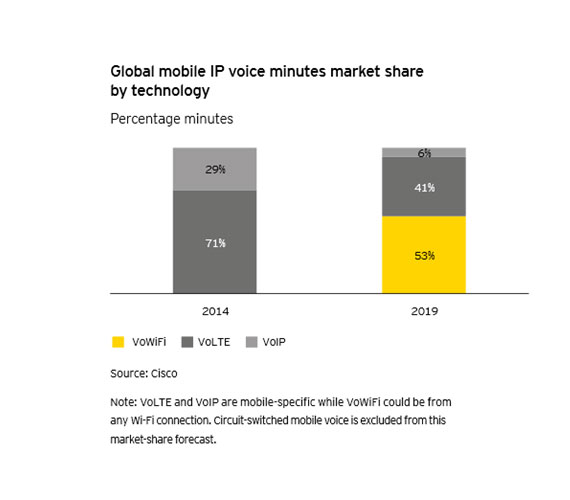The exponential increase in the smart devices and falling call rates is pushing the voice usage services multi-folds. While voice communications continue to evolve we have entered a new era, with Wi-Fi Calling. With Wi-Fi coming in to complement existing networks and helping keep the user connected with better quality, the rise of Wi-Fi Calling is natural. With Wi-Fi calling you can have access to voice services even in areas indoor.
Today’s customers are more mobile, more informed, more demanding and less brand loyal. Coverage is the prime criterion for users in choosing operators; and to meet the ever-expanding expectations of users, Wi-Fi calling can quickly address coverage gaps. Home or office Wi-Fi network or even the Wi-Fi access during international roaming is a boon, with Wi-Fi calling bringing perfect options to a variety of existing issues surrounding voice calls.
Wi-Fi Calling serves as an expedient solution for MNOs to overcome their declining voice ARPUs by enabling them to extend their voice services over data. But there are a few impediments in terms of call drop, device support, security, policy application etc. which Wi-Fi Calling can easily address and offer a seamless voice call experience over Wi-Fi to users.
Wi-Fi Calling success:
Several MNOs globally including EE UK, T Mobile US, Sprint, Bouygues telecom, Swisscom, Orange Europe, Orange Romania, Verizon, Mobifone Vietnam etc. have successfully adopted Wi-Fi calling thus delivering impact with business benefits as stated:
Improved Call Quality: With the best Wi-Fi coverage at access points, user can have seamless HD voice access over Wi-Fi unlike voice breakage and call drops in poor coverage and indoor areas with cellular networks.
Better Coverage: Wi-Fi already accounts for some 50% of smart phone data traffic, the majority of which is generated at home. With mobile data coverage levels often patchy inside buildings, operators recognize the importance of Wi-Fi as a platform for voice calling with better coverage.
Benefits over OTT players: VoIP services revolutionized the way people and enterprises communicated with many relying only on VoIP, resulting in a decline in traditional voice revenue. Unlike OTT, Wi-Fi calling can use native dialler and contacts from the phone. Also, with the increase in the Wi-Fi calling enabled devices, MNOs have a great opportunity to wean their voice users from OTT.
Device agnostic support: Now-a-days with the launch of Gen-X smart devices, most of them have updated in-built native dialler for Wi-Fi calling through which user can access services over any supported device, making it similar to a call made over regular cellular networks.
Better Roaming facilities: With Wi-Fi coverage expanding constantly, there are Wi-Fi hot spots across places in the world. With Wi-Fi Calling as a roaming proposition will curtail roaming charges and large bills as calls from anywhere in the world will be charged as a normal cellular call, providing that you have access to Wi-Fi.
Revenue Opportunities: Marrying Wi-Fi Calling capabilities within existing local or international mobile packages, or indeed residential quad-play bundles, will determine how far richer voice functionality can help MNOs position their voice services over Wi-Fi at a premium.
So, while Wi-Fi calling seems the perfect solution to a realm of business issues – is it the solution for you? For more information on Wi-Fi Calling Solution click here













